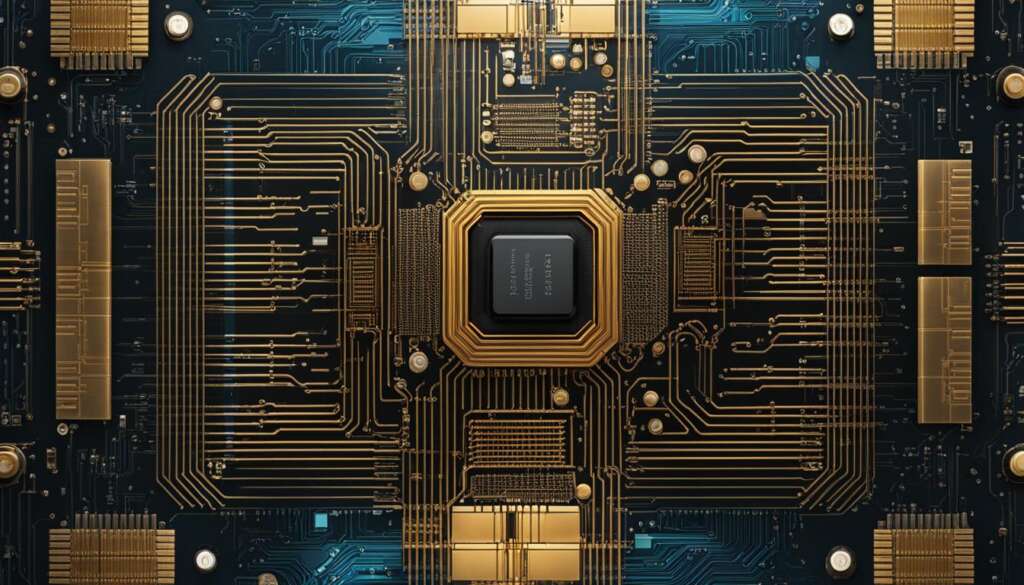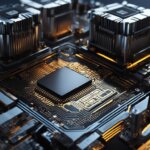Table of Contents
An ARM processor, also known as a central processing unit (CPU), is based on the reduced instruction set computer (RISC) architecture. This innovative technology is developed by Arm Limited, a leading company that licenses its intellectual property to partner organizations for building Arm-based chips.
Arm Limited offers designs for both 32-bit and 64-bit RISC multicore processors. These processors boast a simpler instruction set compared to Intel processors, leading to higher performance and energy efficiency.
Arm processors have made a significant impact in the world of technology. From smartphones and tablets to wearable devices and IoT devices, Arm processors are widely used in a variety of consumer electronic devices.
Over the past three decades, Arm’s partners have shipped an impressive 215 billion Arm-based chips. This speaks to the trust and reliability in Arm’s processor technology and its dominance in the market.
In the following sections, we will delve deeper into the features and advantages of Arm processors, as well as their expansion into new markets. Join us as we uncover the power and potential of Arm processor technology.
Features and Advantages of ARM Processors
ARM processors offer a range of features and advantages that make them a popular choice in various industries. Let’s explore some of these key features:
Load/Store Architecture
ARM processors follow a load/store architecture, which means that data must be loaded into registers before it can be manipulated. This approach helps optimize memory access and enhances overall performance.
Integrated Security
Security is a critical concern in modern computing systems. ARM processors come with integrated security features that safeguard sensitive data and protect against potential threats and attacks.
Orthogonal Instruction Set
An orthogonal instruction set is another notable feature of ARM processors. Each instruction performs a specific task without any side effects, simplifying the programming process and making it more efficient.
Single-Cycle Execution
ARM processors can execute instructions in a single cycle, enabling faster performance compared to processors with longer execution times. This speed advantage contributes to the overall responsiveness and efficiency of ARM-based devices.
Energy Efficiency
Energy efficiency is a critical factor in today’s computing landscape. ARM processors are known for their energy-efficient design, delivering high performance while consuming less power. This feature is especially beneficial for portable devices where battery life is a significant consideration.
64-bit and 32-bit Execution States
ARM processors support both 64-bit and 32-bit execution states, allowing compatibility with a wide range of software applications. This flexibility enables developers to cater to different computing requirements and ensures optimal performance across various platforms.
Hardware Virtualization Support
ARM processors provide hardware virtualization support, which allows for running multiple operating systems on a single processor. This feature is particularly useful in scenarios where virtualization and consolidation of resources are needed, such as in cloud computing environments.
Overall, ARM processors offer a compelling combination of performance, energy efficiency, and flexibility. Their load/store architecture, integrated security, orthogonal instruction set, single-cycle execution, support for different execution states, and hardware virtualization make them a popular choice for a wide range of applications.
ARM Processors’ Expansion into New Markets
Arm processors have not only revolutionized the consumer electronics industry with their presence in smartphones, tablets, and wearable devices, but they have also made their mark in other domains. The versatility of Arm processors has allowed them to find applications in a wide range of sensors and IoT devices, enabling seamless connectivity and data processing in these innovative technologies.
However, Arm processors have now taken a leap into the server market as well. Arm-based servers have gained traction due to their exceptional energy efficiency and superior performance-per-watt characteristics. These servers are increasingly being seen as a viable alternative to traditional x86 servers, offering significant benefits in data centers where energy efficiency is a critical concern.
A standout example is Amazon’s AWS Graviton processors, which integrate Arm architecture into their cloud infrastructure. These processors have achieved impressive results, providing improved compute and cryptographic workload performance while maintaining excellent energy efficiency. Additionally, Arm-based processors have found their way into some of the world’s most advanced supercomputers, showcasing their capabilities in high-performance computing scenarios.
Arm Limited, the company behind these processors, continues to innovate and develop its Neoverse chips to meet evolving demands. These chips promise unparalleled performance and energy efficiency for cloud, edge, and 5G workloads, further solidifying Arm’s position in the market.
FAQ
What is an ARM processor?
An ARM processor is a central processing unit (CPU) based on the reduced instruction set computer (RISC) architecture. It is designed by Arm Limited, a company that licenses its intellectual property to partner organizations for building Arm-based chips.
What are the notable features of ARM processors?
ARM processors follow a load/store architecture, offer integrated security features, have an orthogonal instruction set, can execute instructions in a single cycle, and are known for their energy efficiency. They support both 64-bit and 32-bit execution states and provide hardware virtualization support.
Where are ARM processors used?
ARM processors are extensively used in consumer electronic devices like smartphones, tablets, wearables, and IoT devices. They have also expanded their presence in the market and are now being utilized in servers, data centers, and even some of the world’s fastest supercomputers.
How many Arm-based chips have been shipped so far?
Over the past three decades, Arm’s partners have shipped more than 215 billion Arm-based chips.













